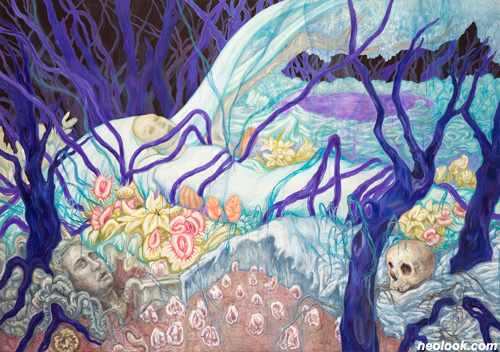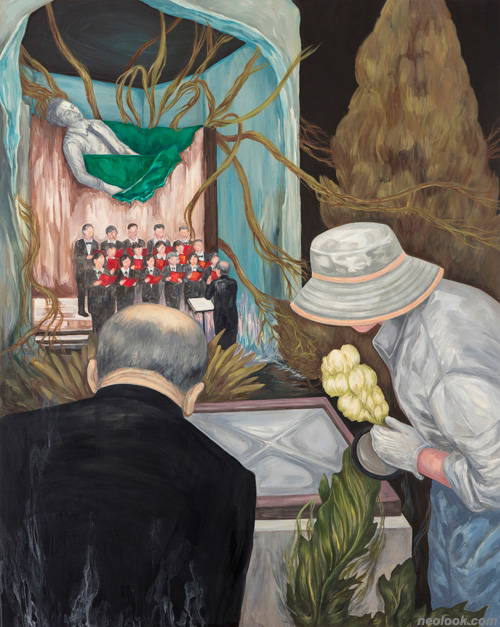- ● homepage
- ● archives
- ● restoration
- ● books
- ● big banners
- ● post board
- ■ neo's search
- ■ about us
- ■ 게재방법 안내
- 개인정보처리방침

- [email protected]
- Tel. 02_335_7922
- Fax. 02_335_7929
- 10:00am~04:30pm
- 월요일~금요일
- 3/3(월) 대체공휴일

겪는 순간, 그림의 결과 Experienced moments and the result of painting
황지현展 / HWANGJIHYUN / 黃智賢 / painting 2017_0426 ▶ 2017_0501
● 위 이미지를 클릭하면 네오룩 아카이브 Vol.20141122e | 황지현展 으로 갑니다.
황지현 홈페이지_www.hwangjihyun.com
초대일시 / 2017_0426_수요일_06:00pm
관람시간 / 수요일_10:00am~06:30pm / 목~월요일_10:00am~06:00pm
동덕아트갤러리 DONGDUK ART GALLERY 서울 종로구 우정국로 68 (관훈동 151-8번지) 동덕빌딩 B1 Tel. +82.(0)2.732.6458 www.gallerydongduk.com
겪는 순간, 그림의 결과 ● 개인이 삶 속에서 겪는 충돌과 감화(感化)의 경험을 회화로 표현하고 있다. 살아가며 직접 겪은 상황들과 신문, 방송, 통신을 통해 마주하는 간접적인 경험까지 그 속에서 느끼는 심리를 감각과 기억을 통해 평면에 표현하는 작업이다. 이것은 다르게 말하면 인간의 '심리학적 장'을 표현하는 것이라 말할 수 있는데, 여기서 '심리학적 장'은 독일의 심리학자 쿠르트 레빈(Kurt Lewin, 1890~1947)의 '장이론(Field Theory)'에서 인용한 말이다. 장이론에 따르면 우리가 존재하는 시공간에는 물리적 공간과 심리적 공간이 존재하고, 인간의 행동에는 물리적 공간과 심리적 공간이 함께 영향을 미친다는 이론이다. 그러므로 어떠한 심리학적 장과 물리적 공간에 놓여 있느냐에 따라 개인의 행동 양식이 달라질 수 있음을 설명하는 이론이다. 또한 심리적 환경의 특성은 개인의 특성에 의해서도 결정되는데, 심리학적 요인이라고 부른 이러한 영향 요인에는 배고픔과 피곤함 같은 내적 사건, 사회적 상황과 같은 외적 사건, 그리고 이전 경험의 회상과 같은 요인들이 포함된다. ● 레빈은 장이론에서 개인과 환경의 상호의존성을 강조했다면, 나는 본인이 경험하는 상황들과 그 속의 심리적 변화, 조형적 표현 방법 세 가지 측면에 초점을 맞추어 작업을 진행한다. 작업의 시작은 본인이 직접, 간접적으로 경험한 순간을 카메라로 이미지를 포착하고 글로 그 순간의 감정들을 기록한다. 그리고 작업을 시작할 때, 당시의 기억과 기록의 흔적들을 상기시켜 화면에 표현할 색을 선정하고 형태들을 그려나간다. 순서를 나누자면 카메라를 통한 1차적 기록, 글과 드로잉을 통한 2차적 기록, 3차적으로 시간이 지나 남겨진 기억을 통해 평면에 표현하는 것이다. 사실 이 과정에는 사건의 기록과 본인이 인식한 이미지, 시간이 흐름에 따라 변해가는 감정들이 서로 혼재되어 유동적으로 영향을 준다.

- 황지현_여기서부터 어딘가로 From Here to Somewhere (Left)_ 캔버스에 아크릴채색, 과슈_140×200cm_2017

- 황지현_여기서부터 어딘가로 From Here to Somewhere (Right)_ 캔버스에 아크릴채색, 과슈_140×200cm_2017
작품의 소재는 본인이 생각하는 일상 속 강렬한 순간들부터 인간의 삶과 죽음까지 비교적 넓게 포착하였다. 하나의 틀과 경계를 두기보다 다양한 사건과 상황들을 선택하였다. 캔버스 200x140cm 네 점의 작품으로 구성된 「여기서부터 어딘가로」는 인간의 탄생부터 죽음까지의 모습을 거시적인 관점에서 바라보는데서 출발하였다. 중앙의 두 점으로 연결된 작품을 보면 자궁, 왕관, 바위, 풀, 사람들 같이 다양한 이미지들이 혼재되어 있는데 이는 개인의 욕망, 가족, 종교에 대한 이야기와 연결된다. 본인의 경험에서 부각되어 인식된 이미지들을 자세하게 묘사하거나 흘러내리고 발산하는 터치들로 화면 위에 표현한다. 미술사, 신화에서 차용한 이미지는 원본의 작품에 뿌리를 두지만, 현 시대를 살고 있는 관객들에게 또 다르게 읽히는 주관적인 해석에 무게를 두고 있다. 주관적으로 선택한 이미지들이지만 온전히 사적이지는 않은 형상들, 이질적이고 동시다발적으로 존재하는 삶 속의 사건들을 담고 있다. ● 네 점 중 가장 왼편의 작품은 마티아스 그뤼네발트(Matias Grunewald)의 「이젠하임 제단화」,(1512~1516) 속 피부병을 앓는 예수의 형상을 현대인의 모습과 혼합하였고, 가장 오른편의 작품은 존 에버렛 밀레이(John Everett Millais)의 「오필리어」,(1851~1852)의 형상을 죽음을 상징하는 오브제들과 함께 표현하였다. 빈번하게 들려오는 사망, 사고 소식을 타인의 고통으로만 치부하지 않으려는 태도와 떠나간 이들에 대한 애도의 의미를 갖는다. ● 작품 「경배」는 할머니의 죽음과 장례절차를 따라가며 겪은 장면들 그리고 한 개인의 죽음에 대한 형상을 원경 중경 근경으로 구성한 작품이다. 근경의 경배하는 이들은 뒷모습으로, 중경의 노래하는 사람들은 얼굴의 이목구비를 자세히 묘사하지 않았다면 오히려 뒤에 있는 한 남자의 모습을 눈에 띄도록 묘사하여 부재(不在)하는 대상에 더욱 초점을 두었다.

- 황지현_경배 Worship_캔버스에 아크릴채색, 과슈_162×130cm_2017
아버지의 출근길 회한 섞인 한 마디, 생일날 가족 식사에서 느낀 복합적인 감정을 표현한 작품 「껍데기」와 「생일상」처럼 본인의 작업에는 생활 속 문득 다가오는 불안감과 함께 사회의 분위기도 큰 영향을 끼친다. 「Offering-1」부터「Offering-3」까지의 작품들은 '봉헌', '헌신'이라는 뜻으로 본인이 다니는 성당 제대의 꽃을 소재로 하였는데, 희생을 기리는 의미의 제대의 꽃들과 여성의 성기 형상, 파리지옥의 형상을 거친 선들과 흐르는 물감의 중첩으로 작업하였다. 이것은 매 주일 마주하는 제대 꽃이지만 당시 안면도 없는 여성을 죽이는 살인 사건과 함께 여성혐오에 대한 문제로 인한 두려움과 분노가 꽃들의 이미지를 다르게 보이게 한 경험에서 비롯되었다. ● 회화에서 그리는 대상에 대한 작가의 인식과 해석은 변형되고 편집된 이미지들을 통해 또 다른 의미의 가능성을 연다고 생각한다. 살아가며 마주하는 순간들과 그 속의 스쳐가는 생각들을 포착하고 심리적 충돌들을 섬세하게 탐구하여 표현하는 것이 작업의 중요한 지점이다. 또한 본인의 작품을 마주하는 이들에게도 흥미로운 미적 경험이 되기를 바란다. ■ 황지현

- 황지현_응시하다 Stare at me_캔버스에 아크릴채색, 과슈_89×260cm_2017
Experienced moments and the result of painting ● I am painting about the conflicts and inspirations that one experiences throughout life. My paintings depict the emotions which are felt in the events of our lives, including the indirect experiences we have, such as from newspapers, public broadcasting and the Internet. I depict this on flat surface sand draw upon human senses and memories. In other words, my painting is about the 'psychological fields' of human beings. The term 'psychological field' is quoted from the field theory of a German psychologist Kurt Lewin (1890~1947). According to the field theory, in space and time where we live, there are physical and psychological spaces, and those physical and psychological spaces influence human behaviors. Therefore, it is the theory which explains that one's pattern of behavior can be changed depending on which psychological field and physical space one is in. Moreover, one's psychological environment can be chosen dependent upon one's characteristics, known as psychological factors. Psychological factors are inner conflicts- such as being hungry and tired, external conflicts- such from a social situation, and the manner in which past experiences are remembered. ● Lewin emphasized the interdependencies between an individual man and environment in the field theory, but I focus on my experiences, psychological changes, and visual methodologies within them in carrying out my works. The starting point is capturing images of my direct and indirectly experienced moments and records my momentary emotions. Then, when making works, the memories and records are recalled when choosing color sand making forms. To be specific, first a camera is used to capture an image, then writing and drawing are done, and the certain left record is revealed on the flat surface. In fact, in this process, the records of events, my specific images of them, and emotions which change as time goes by are mixed to fluidly in order to give influences. ● The subject is comparably broad- from the impactful moments of everyday life, to the life and death of a human being. There is no specific frame or boundary but diverse events and situations. 「From Here To Somewhere」, composed of four canvases in the size of 200 x 140 cm each, beginning at the macro view on the birth and death of a human being. The connected two canvases in the middle contain various images, such as a womb, crown, rock, grass and people, and connect to the stories of one's desires, family, and religion. They came from my own experiences, and are exaggerated by through highly detailed depiction in or by being expressed through flowing down, radiating marks. The images derived from the history of art and mythologies have roots in original images, but my interest is how they are read differently from people living today. The images are not totally personal, and yet they are chosen by a subjective viewpoint discussing events which are disparate and simultaneous in life. ● The canvas on the left depicts a modern person which resembles Jesus with a skin disease in Matias Grunewald's 「Isenheimer Altar」(1512~1516), and the canvas on the right shows a woman in John Everett Millais's 「Ophelia」(1851~1852) with the objects symbolizing death. They represent how I try not to have a callous indifference to the sufferings of others upon receiving news of death and accidents, and my sorrow over people who left early. ● The work 「Worship」is composed of my experiences from my grandmother's funeral from a distant, middle, and close-range view. There are worshipping people from the back in a close-range view, and singing people without clear features, but a person in the back is distinctly depicted and can be seen clearly from a middle view, in order to make the absence of a person stand out. ● In the works 「Shell」 and 「Birthday Dinner」, which refer to my father's blaming words when going to work, and my complicated emotions when having a birthday dinner, I am drawing upon the fear which abruptly comes up in everyday life, and the atmospheres of the society. These themes greatly influence my works. From 「Offering-1」 to 「Offering-3」, the flowers on the altar of my catholic church are the main subject under the meaning of dedication and devotion. The flowers are depicted with female organs and a Venus Flytrapin rough lines and flowing down paints under the meaning of sacrifice. This is because although I have seen the flowers without any feeling on the altar every time I go there, one day, I felt them from a different point of view, stemming from my fear and anger towards the murder case and issues of misogyny in the news. ● I believe that the awareness and interpretation of an artist on a given subject gives the possibility of a different meaning through modified and edited images in painting. I like to capture moments in everyday life as well as my thoughts on them, and express my delicate studies on psychological collision through my practice. Also, I hope that people can have interesting visual experiences from my works. ■ Hwang, Jihyun
Vol.20170426a | 황지현展 / HWANGJIHYUN / 黃智賢 / painting

